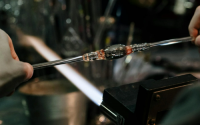Related Chemical Reactions of Molybdenum
Reaction of Molybdenum with Air
Molybdenum is a silver-white metal that is hard and tough. The chemical properties of molybdenum are relatively stable, and it does not react with air or oxygen at room temperature or at a temperature that is not too high.
When molybdenum is heated in the air, it reacts with oxygen to form molybdenum trioxide. Molybdenum trioxide is a white crystalline powder that turns yellow when heated and recovers when cooled. Molybdenum trioxide can be used as a raw material for the preparation of metal molybdenum and molybdenum compounds. MoO3 is used as a catalyst in the petroleum industry. It can also be used in enamel, glaze, paint, medicine, etc.
2Mo(s) + 3O2(g)→2MoO3(s)

Reaction of Molybdenum with Water
Molybdenum does not react with water at room temperature. When molybdenum is heated to 700~800℃ in water vapor, it starts to form MoO2. When it is further heated, molybdenum dioxide is continuously oxidized to molybdenum trioxide.
Reaction of Molybdenum with Halogen
Halogen elements are the seventh group VIIA, including fluorine (F), chlorine (Cl), bromine (Br), iodine (I), astatine (At), referred to as halogen. These elements are typical non-metal elements, and they can be combined with typical metals or alkali metals to form salts.
Molybdenum reacts directly with fluorine (F2) to form Molybdenum hexafluoride at room temperature, under much milder conditions than chromium (next to molybdenum on the periodic table). MoF6 is a white bulk crystal, mainly used for isotope separation of molybdenum. It can also be used in the microelectronics industry for chemical vapor deposition of molybdenum silicide or molybdenum to make low-resistance, high-melting interconnects.
Mo(s) + 3F2(g)→MoF6(l)[colorless]
Molybdenum pentachloride is formed in the reaction between metallic molybdenum and chlorine (Cl2) under carefully controlled conditions. MoCl5 is dark green or gray-black needle-like crystals, deliquescence, and irritating to eyes, skin, mucous membranes and upper respiratory tract. This material is mainly used as a chlorinated catalyst, a component of refractory resins, and can also be used to prepare organometallic compounds such as molybdenum hexacarbonyl.
2Mo(s) + 5Cl2(g)→2MoCl5(s) [Black]
Conclusion
Stanford Advanced Materials (SAM) is a worldwide Molybdenum supplier that has rich experience in the manufacture and sale of molybdenum products. For more information, please visit https://www.samaterials.com/.
Related Posts

Molybdenum Electrode Service Life in Glass Melting

Methods to Improve the Recovery Rate of Molybdenum

